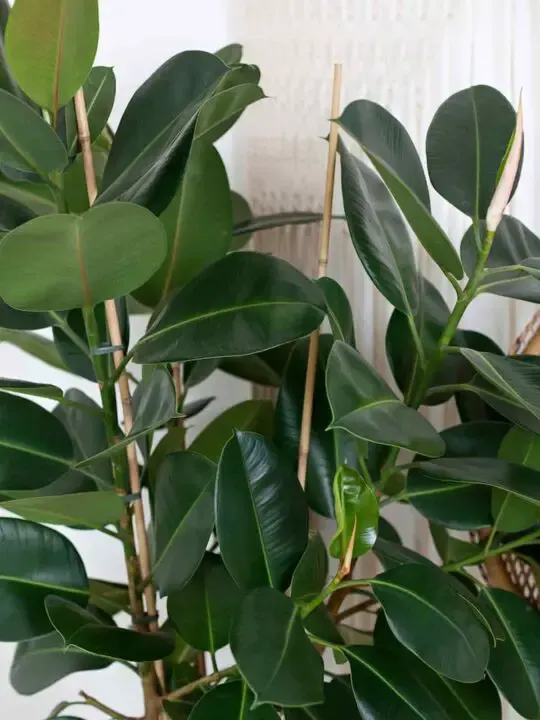The rubber plant is somewhat known for being an excellent addition to your indoor garden. They are easy to care for and are made to be disease, and pest resistant. However, there may come a day when you notice black spots appearing on your rubber plant leaves. Here’s what causes black spots on rubber plants.
Usually, environmental factors like light, physical damage, and water issues cause black spots on rubber plants These things can lead to mold, fungi, and even viral infections, all of which will cause black spots.
Keep reading to learn more about the black spots on your rubber plant leaves, how to treat and prevent this issue, and more!

Main Causes Of Black Spots On Rubber Plants
Black spots are the last thing you want on your plant’s leaves. It can be frustrating, and you probably wonder what is even causing this issue. Let’s take a look at all the reasons why black spots appear on your rubber plant leaves.
Not Enough Sunlight
The rubber plant needs 6-8 hours of light daily. This amount of light will give the plant what it needs to grow. However, the great thing about rubber plants is that they will thrive even if there is only low light.
That said, if they get no light at all and are still being watered, this is the perfect recipe for mold to grow on the plant’s leaves. Since there is no sunlight to help the plant absorb the water, the water sits in the roots, thus creating mold. This will appear as black spots on the leaves.
The discoloration due to sunlight usually takes some time to show itself. Over the course of a few days you’ll notice the changes; typically within 3 to 5 days.

Fungal infection
Fungal infections are commonly spread through spores in the air, watering issues, and soil contamination. The rubber plant is very strong in warding off fungal infections; however, they are still known to contract them from time to time.
Here are some of the fungal infections that rubber plants get.
Septoria Leaf Spot
This fungal disease starts when conditions are too humid and damp. Spots will show themselves on the leaves, tops, and undersides. You will notice mold growth, and withered, wilting leaves, that eventually start to fall off.
Alternaria
Alternaria begins as small black or brown spots on the leaves that eventually take over. The spots may change color over time, getting lighter or darker. Alternaria has a distinctive yellow ring around each spot.
Anthracnose
Regarding fungal diseases, anthracnose is one of the more severe ones. Along the veins, you will notice yellow and brown lines. Spots appear along the leaves; as the disease spreads, the plant will be stunted, lose leaves, and eventually die.
Unfortunately, with all of these diseases, there is no cure. If you suspect your plant is suffering from a fungal disease, you must immediately remove it from your other plants. Throw the plant away, or burn it. Never compost plants that have diseases; it may cause the disease to spread to your soil.

Poor Drainage Leading To Overwatering
If your rubber plant sits in a pot with no drainage, the water has nowhere to go. A plant can only soak up so much water. As the water sits at the base of the roots, and you water your plant daily, this is considered overwatering.
Overwatering can create problems for the rubber plants’ roots. The plant is essentially being flooded. The oxygen and nutrients normally flow freely through the plant’s roots, are having difficulty navigating through the flood.
All this leads to the plant lacking nutrients; its leaves will wilt, have black spots, and even start dying.
Pests
It is a bit harder to contract a pest problem with indoor plants. However, it can happen; once it does, they tend to be harder to eliminate. Rubber plants are susceptible to these pests.
Aphids
Aphids feed along the veins of plant leaves. They suck the sweet sap from the plant and will cause some intense damage. They are tiny bugs that form clusters on the undersides of the leaves.
To get rid of aphids, create a spray of water, vinegar, and a dash of liquid dish soap. Spray your plants liberally. You can also lay Diatomaceous Earth around your plants or Neem oil to help deter aphids.
Thrips
Thrips are much more common in environments that are drier and warmer. They are small, black, flying bugs that attack rubber plants, similar to how aphids attack. They are harder to see with the naked eye, looking like teeny tiny black specks.
Thrips can be removed with an oil-based bug remover.

Ants
More common in outdoor plants; rubber plants will get attacked by ants. Ants will crawl up the stems and slowly chew through the leaves. Ants can be deterred with Diatomaceous Earth, cinnamon, peppermint, and Neem oil.
Scales
Scales are pesky, but they aren’t hard to get rid of. They will slowly eat your plants, leaving holes. They are larger and can be removed with your fingers or tweezers.
Foliage That’s Generating Mold
Rubber plants come from a humid environment. This means that when you have a rubber plant in your home, it is best to keep that plant in a humid environment as well. You also have to be sure to prune your plant from time to time so the leaves aren’t clustered together.
When the leaves are clustered together in a humid environment, they will often generate mold, as they do not have the means to dry off.
Prune your rubber plant at any time of year. With a sharp blade, snip a branch that seems clustered or is dead/has dead leaves.
Bacterial infections
Bacterial infections can spread quickly and easily. From splashed water to shared soil, even human touch can spread bacteria. Bacterial blight is the main bacterial infection that will attack a rubber plant.
Bacterial Blight
Bacterial blight, called crown rot, starts in warm, wet conditions. It appears as small water marks on newer leaves. The disease spreads quickly, so it must be treated right away.
A copper fungicide will be your best bet when fighting bacterial blight. Isolate the plant, and treat regularly.
How do you treat black spots on rubber plant leaves?
First and foremost, you must figure out what is causing the black spots.
For something like overwatering or mold issues, you must first remove the infected leaves. Next, create a new pot (that is well-draining) with new soil. Remove the plant from its old pot, and place it in the new pot. Lightly water the plant into the new soil. Let the plant adjust and dry out for about a week, then continue watering as normal.
Other Preventative Tips
The best way to prevent black spots is to ensure your rubber plant is in an environment in which it can be happy. With decent sunlight, humidity, light waterings once a week, and being in a well-draining pot, this is all your rubber plant needs to thrive.
Final Thoughts
Seeing black spots on your rubber plant can be disheartening. However, once you find the root cause of the spots, they can easily be removed and treated. Hopefully, you catch the issue quickly, so further damage does not harm the plant.

Hi there, my name is Allie and welcome to my blog; GareningWithAllie!
Much of what you see written here is just our personal experiences with gardening. Along with the content I write here, there is also a unique collection of gardening topics covered by some of our close friends. I hope you find everything you read here to be helpful, informative, and something that can make your gardening journey the most lovely experience ever! With that said, Happy Gardening!
